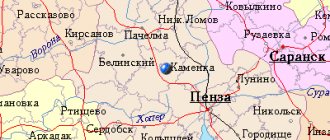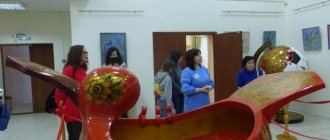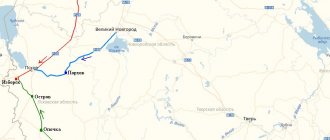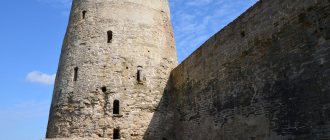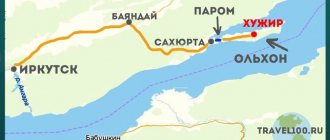The ancient city of Ostrov, located in the Pskov region, is famous for its unusual sights. In the 14th century, it served as a fortress protecting the western borders of Rus' from attacks by enemy troops. Behind the stone walls, the life of the common people was in full swing, who built white-stone monasteries, majestic bridges and estates; subsequently, all this became a legacy of the past and the property of the modern city. Guests of the Island will visit many interesting, breathtaking places. Where to start?
What to see in the city of Ostrov first
You should start your trip around the Island with the most popular and famous attractions. We are talking about the “calling cards” of the city, which you can visit in one day.
Suspension chain bridges
- Coordinates on the map: 57.340469, 28.352367.
Suspension bridges are without a doubt the main asset of the city. These are the only chain bridges in Russia, built in the 19th century and functioning to this day. They were built to facilitate communication between the city and a small island located between the banks of the Velikaya River. Previously, it was possible to get to the island only by ferry or temporary wooden decks, which were constantly destroyed during floods.
Construction of the bridges started in 1851. The project was developed by designer M.Ya. Krasnopolsky. According to his idea, the bridges consisted of two spans located on the same axis and crossed both branches of the Velikaya River. Chain bridges were opened in November 1853. Emperor Nicholas I attended the ceremony.
The structures were particularly durable and reliable. Over the 160 years of existence, they had to be repaired only twice. The first time was in 1926, when the wooden components were replaced with steel parts. And the second time - in 1944, when the southern bridge was blown up by retreating German troops.
Currently, suspension bridges across the Velikaya River are an indispensable element of urban architecture, as well as the main attraction of the Island. There is a tradition among tourists to stop at the bridge and throw a coin into the river to be sure to come back here again.
Siman Spaso-Kazan Monastery
- Address: Malaya Pionerskaya st., 80.
The history of the convent began with a small church in the name of the Savior Not Made by Hands, built by Vladimir Simansky on his estate. In 1896, Vladimir’s descendant, priest Pavel Simansky, left a will, according to which after his death a monastery should be founded on the estate. Paul's will was fulfilled.
In 1897, the Siman Spaso-Kazan Monastery was founded. Its main temple was the Kazan Cathedral. The white stone building in the classicist style attracted attention with its massive helmet-shaped dome placed on a wide round drum. Nearby stood a bell tower, topped with a long spire shining in the sun. At the front entrance there was a small chapel, and a little further away stood the log Archangel Church with a hip roof.
There was a parochial school at the monastery, as well as a girls' school of handicrafts, a hospital and a temperance society.
The monastery ceased to exist in 1918. The parishioners and novices were dispersed, and the buildings were dismantled into bricks. An attempt to restore the monastery was made in 1942. Divine services were held in the surviving buildings during the occupation, but after the Island was liberated from the Germans, the monastery was closed again.
The territory of the ruined monastery remained abandoned until the early 2000s. Restoration work began in 2003 and was completely completed in 2005. The monastery buildings were restored to their original form. Today the monastery operates, actively participates in the religious and social life of the city, and receives parishioners and pilgrims.
Military History Museum of the Pskov Region
- Address: st. Karl Liebknecht, 7A.
The institution began its existence in 1965 as a city local history museum. Later it became a branch of the Pskov Museum-Reserve, and in 2010 it received its modern name and the status of an independent historical and cultural institution.
The museum occupies a two-story building, decorated with expressive white stone platbands. The number of exhibits exhibited there exceeds 5 thousand. The museum's exhibitions are dedicated to various topics:
- History of the city of Ostrov. The life of the city in the museum is literally presented “from and to.” Here you can see both ancient artifacts raised from the depths of the earth, and items of noble life, as well as books, documents and photographs. Of great interest is the model of the fortress that surrounded the city from the moment of its foundation, but has not survived to this day.
- Nature of the Ostrovsky region. The wealth of flora and fauna is reflected in several exhibitions. In the glass cases you can see stuffed wild animals and birds, a huge collection of herbariums and samples of mineralogical rocks.
A separate exhibition is dedicated to the evolution of Russian samovars and tableware. The extensive collection of samovars of various shapes and sizes is amazing, and the collection of antique porcelain sets demonstrates the talent of the craftsmen of the ancient Island.
The highlight of the excursion is the collection of Russian and foreign weapons from the Second World War. The room dedicated to military themes is the largest in the museum. In addition to weapons, authentic documents, samples of military uniforms, and artifacts found at battle sites are presented here. At this exhibition, the history of the military Island is presented in detail and in full.
The Military History Museum not only carries out exhibition activities, but also actively participates in the military-patriotic education of the younger generation. As part of the excursion program and during specially organized events, children get acquainted with veterans, historians, as well as watch documentaries and participate in quizzes.
Nevel is another regional city
For 2022, according to the population census, more than 15 thousand inhabitants are recorded. Nevel has been characterized by constant outflow for more than 20 years.
The city is characterized by a transport problem caused by the cancellation of all commuter trains. The once large Nevel-1 station, located on the outskirts, is now practically non-functional. Diesel locomotives have not been repaired for a long time; only cargo can be transported. Because of this, many residents find it difficult to get to neighboring communities. The situation is saved by buses departing from the bus station. Bus service is also irregular.
Cultural life of the Island: museums and cultural center
Cultural entertainment for guests of the Island will be provided by museums and theaters, which will be interesting to visit not only for adults, but also for children.
Museum-Reserve A.S. Pushkin "Mikhailovskoe"
- Address: Mikhailovskoye village.
“Mikhailovskoye” is the estate of Alexander Pushkin’s mother, where the great poet spent a lot of time. In his youth, he was fascinated by the beauty of the secluded countryside and the leisurely village life. All this inspired the poet and became dear to his heart.
In 1824, Pushkin was accused of being passionate about atheistic teachings and sent into exile, which he served in Mikhailovsky. Village solitude had a beneficial effect on the work of the writer. He now has a lot of time to work, read and think. Here he wrote such famous poems as: “Gypsies”, “Boris Godunov”, “Count Nulin” and others.
The family mansion where the Pushkin family lived has survived to this day. The wooden manor houses a lot of interesting things. Under its shade, 19th-century interiors, personal belongings of the Pushkins, an extensive library and the study of Alexander Sergeevich were preserved.
The excursion also covers the surrounding area of the estate: a landscape park with lakes, ancient bridges and gazebos, as well as a necropolis where the grave of the great poet is located. On the stone tombstone you can see a bas-relief in the form of crossed dueling pistols. At the foot of the monument there are always fresh flowers laid by admirers of A.S. Pushkin.
- Address: st. October 25, 23.
The cultural center is hard to miss. It stands out against the backdrop of city buildings with massive white columns with capitals that greet guests at the front entrance. This monumental building hosts a wide variety of events:
- music concerts;
- theatrical performances;
- movie shows;
- Exhibitions;
- literary evenings;
- children holidays.
The repertoire of the Culture Center includes events for different age audiences. Particular attention is paid here to schoolchildren. Meetings with representatives of the creative elite are organized especially for them, lectures and presentations are prepared on literary, historical and military-patriotic topics.
Architectural gems of the city and surrounding area
The development of the modern Island has retained elements of the ancient city appearance. During the trip, tourists should pay attention to buildings that are more than two hundred years old, as well as the ruins of an ancient fortress - a piece of the Middle Ages.
Estate of the Valuevs-Neklyudovs
- Address: Ostrov-4 quarter.
In the middle of the 18th century, one of the richest and most influential families in the Pskov region were the landowners Valuevs. In the city of Ostrov they owned a huge plot of land, the center of which was a luxurious mansion - the most beautiful architectural structure in the province.
The brick palace impressed with its scale and splendor. Its facade was decorated with rows of faceted columns, the cornices were decorated with expressive stucco and carved patterns, and the walls of the ground floor were abundantly covered with figured masonry. The interior was equally as nice. The rooms were decorated with taste and in the latest fashion. One of the premises housed a house church. High ceilings made it possible to equip choirs for singers.
The majestic mansion was superior in all respects to the surrounding estates, so noble nobles and even members of the Royal Family, in particular Catherine the Great and Nicholas I, stayed overnight there.
At the end of the 19th century, the estate was bought by the nobleman Neklyudov. His descendants owned the mansion until 1917. After the revolution, the estate was confiscated and transferred to an orphanage. Later a university settled in it.
Gradually the building fell into disrepair; there was no money to repair such a large-scale structure, so the ancient palace was abandoned to the ravages of time and vandals. Today, the once majestic building lies in ruins. Only the preserved snow-white columns remind of its former beauty.
Estate of F.V. Semendyaeva
- Address: 25 October street, 25.
The two-story stone house was built at the end of the century before last and belonged to the merchant Semendyaev. At the beginning of the 20th century, the heir to the estate made adjustments to its architectural appearance, from which the building acquired an eclectic style.
During the era of prosperity, the mansion and the surrounding lands had many outbuildings: a barn, stables and carriage house, as well as a beautiful garden.
All this was destroyed with the arrival of the Bolsheviks. The nobles were expelled, and their house was given over to city needs. It housed warehouses and shops for a long time. Currently, the former noble house is occupied by a furniture showroom.
House of merchant Antipov
- Address: st. October 25, 31.
Merchant Antipov was one of the richest merchants on the Island in the 19th century. For a long time, he and his family lived in a complex of wooden mansions, which burned to the ground one terrible night. In place of the destroyed buildings, the merchant erected a new one, this time made of stone. The three-story mansion combined elements of Art Nouveau style and Russian architecture.
It was decorated with carvings, pointed arches and towers with kokoshniks. Unlike the original estate, which did not last long, the stone palace went through revolution and war without losing its beauty. In 1914, a branch of the Real School settled there, which is still located there.
Postal station Yamskaya
- Address: st. K. Marx, 9.
The postal station was built in 1840 on the St. Petersburg – Kyiv route. The one-story stone building was made in a simple style, without frills. Rounded window niches with arched windows add variety to its appearance.
On the façade of the postal station there is a memorial plaque stating that Ostrov became the last city on the life path of Alexander Pushkin. From here he was transported to Mikhailovskoye, where he was buried.
Ostrovskaya fortress
- GPS coordinates: 57.339695, 28.351399.
The Ostrovskaya fortress was built in the 14th century. For centuries, it protected the settlement from enemy raids. Its walls, the thickness of which reached 5 meters, were built from limestone boulders of glacial origin. It is known that the fortress included observation towers:
- Nikolskaya,
- Nizhnyaya Naugolnaya,
- Upper Naugolnye.
Each of them reached a height of 13 meters and had three tiers with loopholes for firearms.
The Ostrovskaya fortress was abolished at the end of the 16th century. During the Great Patriotic War, its remains were completely destroyed. Today on the territory of the former fortress you can see traces of the foundation and ruins. The only completely preserved element is the St. Nicholas Church, built in 1543.
Island
(Pskov region)
OKATO code:
58233501
Founded:
1342
City since:
1342 City of district subordination (Ostrovsky district, Pskov region)
Center:
Ostrovsky district
Telephone code (reference phone)
| 81152***** | 21-2-12 |
Deviation from Moscow time, hours:
0
Geographic latitude:
57°20′
Geographic longitude:
28°21′
Altitude above sea level, meters:
60 Sunrise and sunset times in the city of Ostrov
Temples, cathedrals, churches and monasteries of the Island
The cult buildings of the Island include temples of various religious denominations, architectural styles and periods of construction.
Assumption Pskov-Pechersky Monastery
- Address: Pechory.
The history of the monastery began with a small cave church of the Assumption of the Virgin Mary, which was dug by priest Ivan in 1473. Later, white stone temples were erected on this site:
- The Church of the Intercession is the oldest building of the monastery. The building has only a facade, the rest of it goes into a sandy hill, where the cave church of Ivan has been preserved. In the 19th century it was decorated with multi-colored domes in the Ukrainian Baroque style.
- The Church of St. Nicholas the Gatekeeper is a temple made of white stone blocks, built in the 1560s. The church is the gateway and for a long time served as the main entrance to the territory of the monastery.
- The Great Belfry is one of the largest bell towers in Russia, built in 1532. The tower has seven spans and more than thirty bells. According to legend, three of them were donated to the monastery by the great Russian rulers: Boris Godunov, Ivan the Terrible and Peter I. There is no documentary evidence of this.
- St. Michael's Cathedral is the largest building of the monastery. It was built in 1827 by the Italian architect Luigi Rusca in the classicist style. The cathedral was erected in memory of the liberation of Pskov from the Napoleonic invasion.
- Sretenskaya Church is a building in the pseudo-Russian style, built on the site of the refectory in 1541. This is the only building that has not undergone large-scale reconstruction. The 16th century walls have been preserved under the 19th century decor.
The Pskov-Pechersky Monastery never closed and continued religious activities even during the painful war years. Today it is a center of pilgrimage and attracts thousands of tourists every year.
Trinity Cathedral
- Address: st. October 25, 14.
At the end of the 18th century, Empress Catherine the Great issued a decree to build a new white-stone church on the site of a worm-eaten log church. The decree was executed in 1790.
The cathedral was made in the form of an octagon on a quadrangle with vestibules and arched portals. The octagon was decorated with round windows and a silver dome on the drum. Adjacent to the building was a three-tier bell tower topped with a sharp spire. The temple was rebuilt many times, wealthy parishioners donated large funds for repairs and decorations.
After the revolution and during the war years, the cathedral avoided destruction and reconstruction. It has remained virtually untouched, and today is recognized as a monument of historical and cultural heritage of regional significance.
Church of St. Nicholas the Wonderworker
- Address: st. Kalinina, 2A.
St. Nicholas Church was built in 1543 on an island surrounded by fortress walls. The building is made of stone in the Old Russian style. The quadrangle with porches is crowned with a covered onion dome. Fragments of ceramic patterns with which the church was decorated during construction are still visible on the drum. In 1809, a bell tower was added to the temple.
By the 19th century, St. Nicholas Church remained the only element of the architectural ensemble of the fortress and the old Island. In 1853, bridges were built to its location, which made it much easier for parishioners to get to the ancient shrine.
After the Revolution of 1917, the church was closed, but continued to be protected as a historical monument. The ancient building suffered serious damage during the German occupation. The restoration was carried out immediately after the end of the war and lasted several decades. Today the temple has been completely restored, and services are regularly held there.
Church of the Myrrh-Bearing Women
- Address: st. Liberation, 8.
The baroque stone church was built in 1819 with funds from local merchants. It is located in an ancient cemetery where rich merchants and nobles were buried. At the end of the 19th century, the territory of the church and cemetery was surrounded by a stone fence. At the same time, a gate was built.
The church, the adjacent chapel and the necropolis were not damaged during the Soviet years. In 1990, services were resumed in the church, which had been empty for a long time. The building was repaired, refreshed, and the territory of the necropolis was ennobled. Today the church is operational, and the cemetery is protected as a historical monument.
Church of St. John
- Address: st. Liberation, 19.
The only Lutheran church in the city was built at the beginning of the 20th century. The building is made of red brick in the Romanesque Gothic style. In 1917, the building was nationalized and lost its bell tower and decorative elements.
For a long time the church stood in disrepair. It was put in order only in the late 1990s. At the same time, it was recognized as a monument of regional significance and completely restored. Today the building houses the tax department.
City `s history
The Island was first mentioned in the chronicle in 1341; it was not just a large city, but also an important outpost in the south of the Pskov land. Its history began with military events, when a fortress was built on a small island formed by the Velikaya River and its channel Slobozhikha to protect against attacks of the Livonian Order. The stone fortress was one of the largest in Ancient Rus'. The power of the fortress is obvious; five towers and a zakhab make its appearance very formidable.
In 1542, the Church of St. Nicholas was erected on the territory of the fortress, as severe and powerful as the fortress itself.
Unfortunately, tourists will not have to see the Ostrovsk Fortress: what time has spared, the war has not spared.
In August 1581, the fortress fell after a three-day assault by the Poles and remained under enemy rule until March 1582. Over the coming years, the fortress suffered desolation and impoverishment; the Island remained a provincial town. But, as in many cases in Rus', thanks to the merchants, economic, if not prosperity, then well-being came to the city. The flax trade, bristle and leather industries turned out to be profitable for both merchants and the city treasury. The island revived, which was facilitated by the opening of sections of the Ostrov-Pskov and Ostrov-Dinaburg railways in the 19th century. In the 20th century, the city suffered during the Second World War, and after it, the military installations located in its immediate vicinity brought some fame to the city.
Memorials and monuments in Ostrov
Numerous monuments and sculptures decorate the streets of the Island. Most of them are dedicated to the events of the Great Patriotic War. These are majestic monuments that prevent the exploits of the past from getting lost in time and disappearing from the memory of the modern generation.
Obelisk "Victory Peak"
- Address: Victory Park.
The obelisk was installed in Victory Park in 1969 in memory of the liberation of the city from the fascist occupiers. The monument is made of stone and rises into the sky with a sharp spire. A memorial inscription and historical information about the events of November 1944 are carved on the base. Every year on Victory Day, rallies are held at the obelisk, and townspeople lay red carnations and wreaths at its foot.
Monument to Pavlik Morozov
- Address: st. October 25, 51.
The monument to the pioneer hero who was brutally killed in the fall of 1932 was erected in 1966 at the entrance to school No. 2. The bronze figure was created in Leningrad at the expense of Ostrov schoolchildren, who handed over scrap metal, waste paper and participated in agricultural work. The money received was put into a common piggy bank. The figure of Pavlik Morozov is placed on a cubic pedestal, in the center of which there is a memorial plaque.
Monument to Klava Nazarova
- Address: Center block.
Klava Nazarova is a native of Ostrov, who during the war years headed an underground Komsomol organization whose task was to resist the fascists. Members of the detachment obtained information about the actions of the Germans and passed it on to the partisans, after which they planned attacks on the invaders. Under the leadership of Klava, Komsomol members helped fifty prisoners of war escape from a German camp.
The occupiers knew about the existence of the Komsomol detachment, but could not detect it until they received a denunciation of Claudia. In November 1942, the girl was arrested and tortured for about a month. On December 12, Claudia was publicly executed. For three days her body remained on the gallows, after which it was buried.
For her heroism and courage, Claudia Nazarova was posthumously awarded the title of Hero of the Soviet Union, and in her hometown a memorial sculpture depicting a girl in full height with her head held high was erected. The memorial was placed in the central square of the city, which was later renamed in honor of Nazarova.
Memorial to the Great Patriotic War at the military cemetery
- Address: st. October 25, 19.
The mass grave is located near the monument to Klava Nazarova. In 1918, revolutionaries who fought for the establishment of Soviet power were buried here, and in 1944, heroes who died during the liberation of the city from fascist invaders were buried here.
In the post-war years, marble slabs with the names of Soviet soldiers were installed over the burial. Among them is twenty-year-old Major T.S. Rymar, whose unit was the first to break into the captured city.
Exhibition of military equipment
- Address: Children's Park.
Across the road from Claudia Nazarova Square there is a small children's park, where, in addition to gazebos and swings, there are examples of military equipment: ground and airborne. 1940s appliances, refurbished and given a fresh coat of paint, sit on concrete pads. Children can not only inspect combat vehicles, but also climb onto them and sit in the cockpits.
Monument to A.A. Shumeiko
- Address: st. Shumeiko, 8.
From his youth, Alexander Andreevich Shumeiko was brought up by a partisan detachment and in later life participated in many military conflicts, and also worked at an aircraft factory where the TU-2 bomber was created. He later became a scorer himself.
During the Second World War, Alexander served in a bomber division and made many successful missions. In June 1944, during heavy shelling, Major Shumeiko died heroically, having managed to defeat the enemy. He was posthumously awarded the title of Hero of the Soviet Union.
In the name of A.A. Shumeiko named one of the streets of the Island, on which a memorial was erected in his honor.
Monument to the Crew of TU-16
- Address: Apakidze street.
On July 13, 1988, near the Island, the TU-16 missile carrier crashed during combat training, as a result of which all crew members were killed. The causes of the disaster remain unknown.
A year after the tragedy, a memorial was erected in the city, representing a bird’s wing surrounded by a ribbon with bas-reliefs of six pilots. The opening ceremony of the monument was attended by relatives and colleagues of the victims. Since then, a meeting has been held annually at the foot of the monument and a memorial service has been celebrated.
Chernobyl memorial
- Address: st. October 25, 14A.
The monument was erected in April 2010 in honor of the 24th anniversary of the Chernobyl disaster. It is made in the form of three black slabs (one large and two small on the sides), on which memorial inscriptions and historical information are engraved. On the opening day, townspeople, deputies, schoolchildren and clergy gathered in the square where the monument was placed.
The monument is located on the banks of the Velikaya River. From here you can enjoy a panoramic view of the island and the Church of St. Nicholas the Wonderworker.
Nature of the city of Ostrov and its surroundings
The nature of the Island is very picturesque. River banks, tree groves and ancient parks - all this will not leave tourists indifferent.
Vrevsky Estate Park
- Address: Ostrovsky district, Golubovo village.
The estate of the Vrevsky nobles was built in the 1830s. It was a small stone building, reminiscent of an old Russian tower. Alexander Pushkin visited the estate several times. Baron Vrevsky's library was unusually rich (more than 3 thousand books), and the poet often used it.
After the Revolution of 1917, the Vrevskys hastily left the country, leaving their home. The estate was completely burned by the Bolsheviks. Today, only inconspicuous ruins remain from it.
Despite the fact that the noble mansion has disappeared, the adjacent park has been preserved. The territory covers nine hectares, the terrain here is mostly hilly. Shrubs such as acacia, lilac, serviceberry and rowan grow in large quantities in the park. Some trees are up to a hundred years old - they were planted by the Vrevskys. Since the time of the barons, the park has also preserved a pond in which wild ducks swim.
Great River
- Coordinates: 57.339747, 28.346154.
The Velikaya River divides the city in two and wraps its arms around the small island from which its history began. The river is a favorite place for townspeople and tourists. Green groves and meadows stretch along its banks.
Here you can admire nature and city attractions to your heart's content. There are rafting trips on the water in canoes, rowing and motor boats, which can be rented. In some places there are beaches, and fishermen like to settle away from the noisy crowd.
Don't miss reviews of other cities in the Pskov region:
- Pskov, Pechora, Izborsk,
- Pushkinskiye Gory, Velikiye Luki,
- Sebezh, Gdov and Porkhov
The Pskov region is secretly divided into “tourist” and “non-tourist” parts. And the Island is most often referred to as the latter. This opinion is completely wrong, because it is in this city that some of the oldest and most interesting tourist sites in the region are concentrated. Having visited the Island, everyone can say with confidence that this glorious city truly deserves the title “Island of Sights.”
Tourist information
- Population: more than 290 thousand people.
- Area - 214 km².
- Language: Czech.
- Currency: Czech crown.
- Time: UTC +1, summer +2.
- Ostrava is a major transport hub in Eastern Bohemia. You can get here by high-speed trains from Prague, Brno, Olomouc, Katowice and Warsaw. There are also direct train connections to Vienna, Bratislava, Budapest, Krakow and Moscow.
- Ostrava has a small international airport with flights to London, Milan and Dubai.



